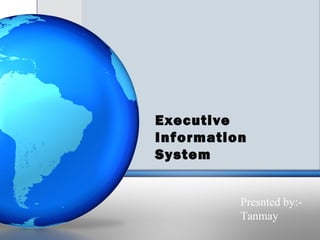
Eis
- 1. Executive Information System Presnted by:- Tanmay
- 2. WHAT EXACTLY IS AN EIS? • An EIS is a special type of DSS designed to support decision making at the top level of an organization. • An EIS may help a CEO to get an accurate picture of overall operations, and a summary of what competitors are doing. • These systems are generally easy to operate and present information in ways easy to quickly absorb (graphs, charts, etc.).
- 4. EXECUTIVE INFORMATION NEEDS • Decision making (by providing data) • Scheduling (to set agendas and schedule meetings) • Email and electronic briefing (to browse data and monitor situations) • Majority of personal DSS support the work of professionals and middle-level managers • Organizational DSS support planners, analysts, and researchers. • Rarely do top executives directly use a DSS
- 5. HOW TO FIND EXECUTIVE’S INFORMATION NEEDS Wetherbe's Approach [1991] 1. Structured Interviews IBM's Business System Planning (BSP) Critical Success Factors (CSF) Ends/Means (E/M) Analysis 2. Prototyping Watson and Frolick's Approach [1992] Asking (interview approach) Deriving the needs from an existing information system Synthesis from characteristics of the systems Discovering (Prototyping) Ten methods
- 6. EIS IMPROVEMENTS IN EXECUTIVE JOB PERFORMANCE ABILITY - Enhanced communications - Greater ability to identify historic trends - Improved executive effectiveness - Improved executive efficiency - Fewer meetings and less time spent in meetings - Enhanced executive planning, organizing, and control - More focused executive attention - Greater support for executive decision making - Increased span of control
- 7. EIS CHARACTERISTICS Tracking and Control Tool Excellent Graphics Very User-Friendly Provides Rapid Access to Current Information Problem Solving vs. Opportunity Assessment Tailored to executive’s information needs Reports “Drill-down” process
- 8. REPRESENTATIVE EIS SOFTWARE Product Vendor Command Center Pilot Software Commander Comsahre Inc. EIS Tool Kit Easel Corp. Executive Decisions IBM Corp. Focus Channel Computing LightShip Pilot Software The SAS System SAS Institute Inc.
- 9. PURPOSE OF AN EIS • Gives managers access to the data • Promotes managerial learning • Provides timely information • Looking at the data leads to questions • Identifies trends • Measures performance
- 10. TYPES OF EISs • Corporate Management • E.g., Management functions, human resources, financial data, correspondence, performance measures, etc. • Technical Information Dissemination • E.g., Energy, environment, aerospace, weather, etc.
- 11. STRUCTURE OF AN EIS • Presentation Graphics • Tutorials • Web Pages • Internet Portals • Intranet • Database Queries and Reporting
- 12. TOOLS • Database Interfaces • Queries • Forms • Modules (Code) • Hypertext Interfaces • Active Server Pages (MS ASP) • Off-the shelf Software • Custom Programming
- 13. EIS COMPONENTS • Early EIS products were developed for use on high-powered computers, but current products target the client/server platform. • These more-flexible platforms can adapt to changes in the organization and in technology. • Use of real-time data leads to faster, more informed decisions.
- 14. HARDWARE COMPONENTS • An EIS requires no specific or unique hardware. • A key issue is to be sure that the EIS components optimize and conform to the organization’s computing resources. • The system must be configured so that the resources are well-matched to the executives using them.
- 15. SOFT WARE COMPONENTS • In contrast to hardware, software is usually highly specialized to the problem domain. • This specialization is often achieved by using off-the- shelf components for the EIS backbone, and customized modules to meet specific needs. • Lotus Notes is a good example. It can be used alone, or can accommodate third-party plug-in modules.
- 16. EIS OPERATIONAL SUCCESS FACTORS • Deliver timely information • Improve efficiency • Provide accurate information • Provide relevant information • Ease of use • Provide access to the status of the organization • Provide improved communications An EIS for upper management must fit with their decision styles
- 17. DETERMINATES OF EIS ACCEPTANCE • Rapid Development Time • Staff Size • EIS Age • Not Ease of Use • Not High Usage • Not Many Features • Not a Staff Close to Users
- 18. FACTORS CONTRIBUTING TO EIS FAILURES • Technology-related factors • Support-related factors • User-related factors • Most EIS fail because they do not provide value for their high cost though EIS benefits are difficult to measure
- 19. SOME EIS LIMITATIONS AND PITFALLS TO AVOID • Cost: a 1991 survey showed an average development cost of $365,000 with annual operating costs of $200,000. • Technological limitations: the EIS needs to be seamlessly integrated into the company’s current IT architecture, so it is a formidable challenge to the designer. • Organizational limitations: the organizational structure might not be right.
- 20. CURRENT TRENDS IN EIS • More enterprise-wide EIS with greater decision support capabilities • Integration with other software (Lotus Domino / Notes and World Wide Web) • More intelligence - intelligent software agents
- 21. THE FUTURE OF EIS Several conditions will merge to transform the technology. Some are easy to predict, some not. Two that we can foresee are: • Increased comfort with computing technology in the executive suite will make innovations more readily accepted. • Broadening of executive responsibilities will broaden the demand for information.
- 22. THANK YOU
